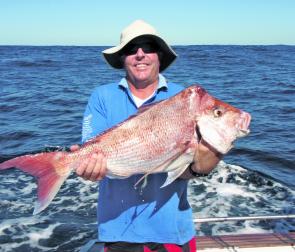The water will be cold and green in July, and this means one thing – snapper time! The Gold Coast snapper fishery can be red hot and there are numerous ways to get among the numbers of these sought-after sport fish.
My favourite way to catch snapper is on lightly weighted baits slowly drifted to the bottom. I use the lightest weight possible and often find myself changing weights several times in a session to make sure I’m getting the most out of my time fishing.
When using this method (known as float-lining) I like to present my bait so it doesn’t sink too quickly. I would rarely use a weight heavier than about a 5 ball, or about an 1oz. I only use McCubbin Glow Sinkers when fishing like this, that glowing sinker makes a huge difference when it comes to attracting a big snapper. Particularly if your fishing in water 50m or less.
My preferred bait is pilchards, mostly because you will catch snapper of any size on this bait. Additionally, I also use stripped flesh bait such as tuna or mullet, and squid is also very good at times. If possible try to take a variety of baits out with you.
I have also done very well on soft plastics while fishing for snapper. I fish my plastic much like I fish my bait; I try to use the same weight jighead as I would a sinker and I like it to always be descending. Most of the time when my plastic gets to the bottom (if it hasn’t been eaten already) I will give it a few hops then wind it back in and let it sink down again. Nearly all the bites you get will be as the lure sinks.
A few places to start fishing are the 18, 24 and 36 fathom lines south east of the seaway, off Surfers Paradise and the Mud Hole at the Tweed.
Cobia should be starting to get around now, and simply by putting out a big live bait while you are fishing for snapper will often get the attention of a big specimen. These fish cruise the reefs and will pass though all the local snapper ground so it’s well and truly worth while having a bait out for one. I use a double hook rig with two hooks ranging from 5/0 to 10/0 depending on the bait size, and a leader of around a metre and about 80lb in strength with a fairly big sinker. I use a big sinker purely so the live bait can’t swim around too much and tangle other lines. I use 30-50lb tackle as fish well over 30kg are often encountered.
There will also be a few yellowfin around on our wider grounds. Use a variety of lures such as skirted pushers and bibbed minnows such as Halco Laser Pros. These fish can be really fussy feeders, so by using a selection of lures, you will increase your chances of catching a few.
Diving birds are a big indicator of yellowfin schools, so keep your eyes peeled at all times.
Big numbers of flathead should start showing their faces around Crab Island, all of the banks in the Broadwater and the mouth of Currumbin Creek. Use fairly small plastics 2-4” long at this time of year as the fish you are chasing will mostly be smaller school flathead, 40-60cm in length.
Work drop-offs and weed beds for best results, and if any bait is present, like schools of white pilchards, spend time fishing around them as predators such as flathead won’t be far away.
School jew will be hanging around the mouths and any deeper sections of the rivers. Soft plastics 4-6” are best and use heads weighted accordingly with water depth and tidal flow. Work your plastics slow and along the bottom, and the simple technique of letting the plastic fall to the bottom and then two hops upwards and allowing it to sink again is what I find most effective. Remember legal size in Queensland is 75cm on jew and all fish under that must be released.
Garfish will be around; use a bread-based berley while anchored around any broken bottom on the southern end of the Broadwater. It shouldn’t be long before you have a mass of these little guys in your berley trail.
Gar are fantastic bait and even better eating and, with the help of the right gear, aren’t that hard to catch. I use a small pencil float weighted down with a split shot and a small cube of prawn or yabby. These fish have a very small mouth so a very small hook is a must. I find a long shanked hook in a size 10 works best.
Bass in the Hinze will be mainly holding up in deeper sections of the dam as well as hanging off the more predominant points. Use a sounder to locate schools of bass and then work your lures through them. Ecogear VT 65 are about my favourite lure for this type of fishing but bass will also hit a wide variety of paddle-tailed plastics on 1/4oz jigheads.
Reads: 2257
Mark Morland with a decent snapper caught while float-lining.

The author with a cobia caught on an Atomic plastic while float-lining for snapper.




